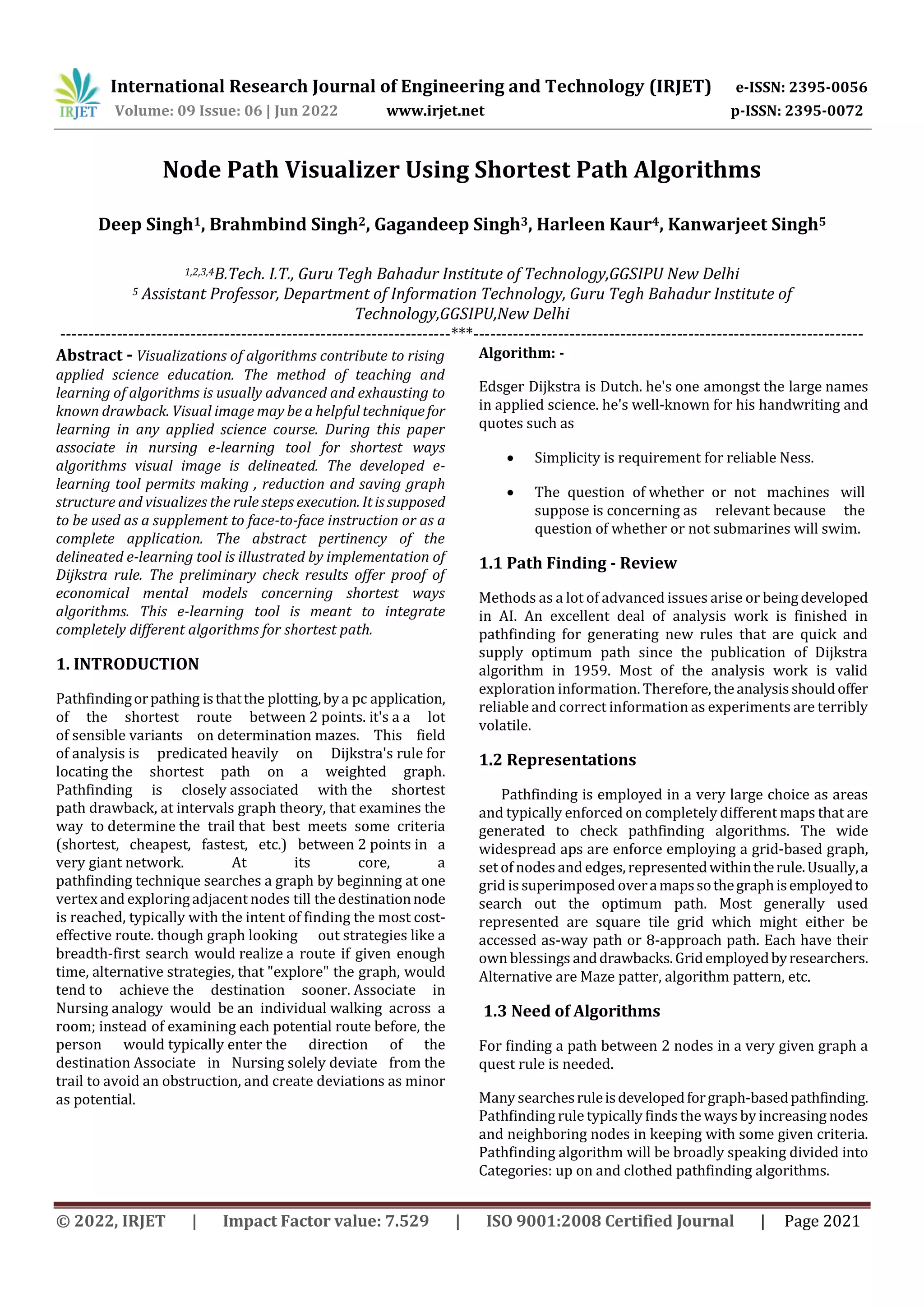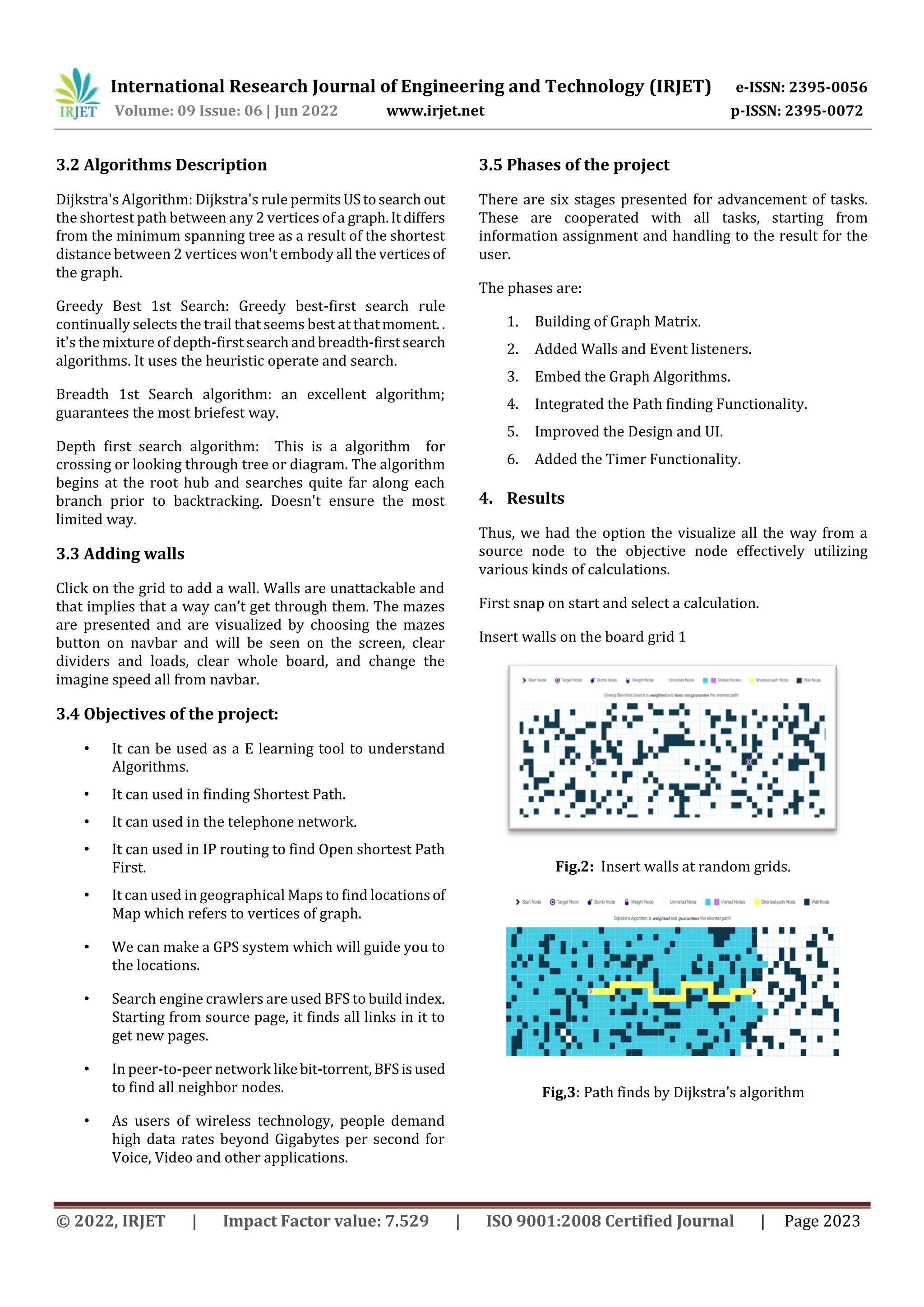This document describes a tool for visualizing shortest path algorithms. The tool allows users to create and save graph structures and visualize the step-by-step execution of algorithms like Dijkstra's algorithm. It is intended to supplement classroom instruction or be used as a complete e-learning application. The tool implements grid-based graphs and allows selection of different pathfinding algorithms to find the shortest path between two nodes. Algorithms can be unweighted or weighted based on node values. The tool aims to help students better understand shortest path algorithms through interactive visualization.

![International Research Journal of Engineering and Technology (IRJET) e-ISSN: 2395-0056 Volume: 09 Issue: 06 | Jun 2022 www.irjet.net p-ISSN: 2395-0072 © 2022, IRJET | Impact Factor value: 7.529 | ISO 9001:2008 Certified Journal | Page 2022 As the names suggested up on means that having previous information concerning the matter house before looking out it. Up on search refers to the utilization of information concerningthesearchedhouselikedrawbackmap,calculable prices, associate in nursing estimate of goal location. Thus, the rule utilizes this information whereas looking out a path and it makes pathfinding quick, optimum and reduces memory usage in node enlargement. Numerous algorithms that be this class ae A*, Dijkstra’s Greedy, Swarm and plenty of a lot. These algorithms use completely different heuristic operated or uniform price operate to utilize the functions. 2. LITERATURE REVIEW Literature Review is needed to require the matter into concerns that can’t be cleared within the past researches. several researchers attempt to interpret numerous quite conclusions and to boost those past results literaturereview is required. this literature serves several varied fascinating options, that forms the important background for the study and conducted a thought. An important field of mathematical theory is that the mathematical study of the structureofabstractrelationships between objects by means that ofgraphs(networks).though work of those constructions will be strictly theoretical, they'll be wont to model try wise relationships in several globe systems. one amongst most generally exploitation applications is determination of shortest ways in several sensible applications as: maps; automaton navigation; texture mapping; typesetting in TeX; urban traffic planning; optimum pipelining of VLSI chips; subroutines in advanced algorithms; telemarketer operator scheduling; routing of telecommunications messages; approximating piecewise linear functions; network routing protocols (OSPF, BGP, RIP); exploiting arbitrage opportunities in currency exchange; optimum truck routing through given hold up pattern. 2.1 DATA STRUCTURES In practice, graphs are typically pictured by one amongst 2 commonplace information structures: closeness lists and closeness matrices. At a high level, each information structures are arrays indexed by vertices; this needs that every vertex encompasses a distinctive number symbol between one and V. in a very formal sense,theseintegersare the vertices. 2.2 ADJACENCY MATRICES The other commonplace arrangement for graphs is that the closeness matrix, 1st projected by Georges Brunel in. The closeness matrix of a graph G may be a may be a V matrix of 0s and 1s, commonly pictured by a two-dimensional array A[1 .. V, 1 .. V], wherever every entry indicates whether or not a selected edge is gift in G. Specifically, for all vertices u and v if the graph is adrift, then A[u, v] := one if and as long as actinic radiation a pair of E, and if the graph is directed, then A[u, v] := one if and as long as actinic radiation a pair of E. For adrift graphs, the closeness matrix is usually bilateral, which means A[u, v] = A[v, u] for all vertices u and v, as a result of actinic radiation and vu are simply dierent names for an equivalent edge, and also the diagonal entries A[u, u] are all zeros. For directed graphs, the closeness matrixcould or might not be bilateral, and also the diagonal entries could or might not be zero. Given Associate in Nursing closeness matrix, {we can/we will/we are able to} decidein ⇥ (1)time whether or not 2 vertices are connected by a footing simply by wanting within the acceptablefindtimeforthematrix. we are able to additionally list all the neighbours of a vertex in ⇥ (V) time by scanning the corresponding row (or column). This period of time is perfect within the worstcase,however though a vertex has few neighbours, we have a tendency to still got to scan the complete row to search out all. Similarly, closeness matrices need (V2) house, notwithstanding what number edges the graph truly has, in order that they are solely space-evident for terribly dense graphs. Fig.1 Dijkstra’s working 3. Methodology In this section, the operating of the project has been delineated, however the project started and the easy the project works and the way the varied phases of projectwere administrated and also the challenged round-faced at every level. What will the project do? Attheessential,a pathfinding seeks to search out the shortest path between 2 points, this project visualizesnumerous pathfindingalgorithmsinaction and a lot of. The algorithm during this project has been custom-made and for 2nd grid, wheneverninetydegreeturns have a “value” of one and movements from a node to a different have a “value” of one. 3.1 Picking an Algorithm Choose associate in nursing rule from the “Algorithms” menu. Note that some algorithms are unweighted, whereas others are weighted. Unweighted algorithms don’t act or weighted node into consideration whereas weighted ones do. Also, not all algorithms guarantee the shortest.](https://image.slidesharecdn.com/irjet-v9i6378-221013084401-4af9c17c/75/Node-Path-Visualizer-Using-Shortest-Path-Algorithms-2-2048.jpg)

![International Research Journal of Engineering and Technology (IRJET) e-ISSN: 2395-0056 Volume: 09 Issue: 06 | Jun 2022 www.irjet.net p-ISSN: 2395-0072 © 2022, IRJET | Impact Factor value: 7.529 | ISO 9001:2008 Certified Journal | Page 2024 Fig.4: Representation of connected nodes 5. CONCLUSIONS With the fruition of this project, we have effectively accomplished our target of our task is to implant Graph Path Finding with Visualization and Comparing their exhibition. Just like with most other showing regions, there has been a critical hole between the hypothesis and functional comprehension of calculations acknowledgment. This is valid additionally for most brief ways calculations and specifically for Dijkstra calculation. The principal objective of the task is to utilize it from activities research instructors and understudies for educating and concentrating on the current known combinatorial chart calculations. The principal thought of the framework is to give a coordinated instructive climate to the two teachers and understudies to work with the educational experience in proficient manner. To finish up, we have gained some significant experience of things working under this venture. We are likewise appreciative to our guide and managerfortheir endeavorsin the educational experience. REFERENCES [1] https://www.geeksforgeeks.org/graph-data-structure- and-algorithms/ [2] https://en.wikipedia.org/wiki/Pathfinding [3] https://www.w3schools.com/js/ [4] https://www.meta-chart.com/histogram [5] https://www.geeksforgeeks.org/dijkstras-shorte st- path-algorithm-greedy-algo-7/ [6] https://youtube.com [7] https://www.geeksforgeeks.org/a-search-algorithm/ [8] https://www.researchgate.net/publication/28248830 7_Pathfinding_Algorithm_Effi ciency_Analysis_in_2D_Grid [9] http://tesi.fabio.web.cs.unibo.it/twiki/pub/Tesi/Docu mentiRitenutiUtili/p80-ardito.pdf [10] Ahuja R. K., Magnanti, T. L. & Orlin, J. B. (1993). Network Flows: Theory, Algorithms and Applications. Englewood Cliffs, NJ: Prentice Hall. [11] Dijkstra, E. W. (1959). A Note on Two Problems in Connection with Graphs. Numeriche Mathematik, 1, 269271. [12] Fouh E., Akbar M. & Shaffer C. A. (2012). The Role of Visualization in Computer Science Education. Computers in the Schools, 29(1-2), 95-117. [13] Roles J.A. & ElAarag H. (2013). A Smoothest Pathalgorithm and its visualizationtool. Southeastcon, In Proc. of IEEE, DOI: 10.1109/SECON.2013.6567453.](https://image.slidesharecdn.com/irjet-v9i6378-221013084401-4af9c17c/75/Node-Path-Visualizer-Using-Shortest-Path-Algorithms-4-2048.jpg)